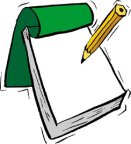Getting your research program off the ground or even sustaining a productive lab requires funding. In this post, Dr. Bridget Gourley follows up with advice and strategies on leveraging smaller resources in a chilly funding climate.
Last time, in Part 1, I shared the idea of being attentive while randomly trolling communications from your professional network to find sources of funding for student travel to a professional meeting. But maybe you were thinking, “Wait a minute, my needs are earlier in the process – I need results to present at a meeting.” You are a bright scholar. You were successful obtaining a position teaching and mentoring students. You have research ideas you want to implement. Yet science takes resources, and right now resources seem a bit thin. This post is designed to start you thinking about places you might find a few resources.
Take Note
 I support active learning in my classes, so you need to take an active approach to reading this blog post. As you read I encourage you to jot down some notes. Humor me. Grab a couple pieces of paper, notebook, something that two weeks from now when you get back to this task you can find. It will be a couple of weeks before we get to finish this story. I predict the notes I am going to ask you to generate will provide a framework for finding smaller pockets of money or other resources to support your work.
I support active learning in my classes, so you need to take an active approach to reading this blog post. As you read I encourage you to jot down some notes. Humor me. Grab a couple pieces of paper, notebook, something that two weeks from now when you get back to this task you can find. It will be a couple of weeks before we get to finish this story. I predict the notes I am going to ask you to generate will provide a framework for finding smaller pockets of money or other resources to support your work.
Make a quick written note of a project for which you are looking resources as the title of your piece of paper or journal entry. Next, take the page and divide it into two columns. On the left had column enter a subheading, “Resources Needed.” As you read this post take your brainstorming a step further. What is it that you need for the project? Start with the first item from my last blog post, travel funds for you and/or a student. However, think about that travel more broadly, certainly the purpose of the travel could be to attend a conference, but a more pressing need might be travel funds for fieldwork, to visit an archive, use an instrument elsewhere, etc. After listing travel, jot a note about where that travel needs to take you.
Regarding your other needs…you might just want to say “money”. Sure, it’s easy to say “money”, but ultimately for this exercise it will help to be a bit more specific. What else do you need funds for? Is it expendable supplies, for example, chemicals or disposable sample cells? Or perhaps, small durable supplies, beakers, spatulas, and the like? Do you need a piece of equipment, if so what type and what are the necessary specifications to take the measurements you need? Are the funds to pay for instrument time or an analysis by another lab? Perhaps, salary, summer or otherwise for a student or even yourself, is your most pressing financial need. (Don’t forget your contributions are worthy of payment within the guidelines allowed by your institution.) Are you close enough to a sabbatical to be looking for a salary supplement so you can take the full year rather than a semester?
Sometimes, what you need doesn’t have to be categorized as monetary support. When you shift your thinking, you can open your eyes to resources you didn’t realize were available.
Money doesn’t solve all the problems we have doing science with undergraduates. When scrambling for ways to jump-start your research, thinking only about funds is ultimately short-sighted. I want you to be innovative. Sometimes, what you need doesn’t have to be categorized as monetary support. When you shift your thinking, you can open your eyes to resources you didn’t realize were available (more on that in Part 3).
 Back to that active participation while reading. Think about your needs that have more of an indirect relationship to funds.
Back to that active participation while reading. Think about your needs that have more of an indirect relationship to funds.
I’ll offer up a few suggestions to get your creative juices flowing. The most useful thing might be a conversation or collaboration with someone whose expertise would complement your own? How about access to a collection in a museum, library, or archive? Do you really need another instrument that you yourself must maintain, or would it be possible to gain access to an instrument that someone else already maintains? At this point I hope you have some things in mind I haven’t mentioned and that’s great, write them down! Whatever needs come to mind, jot them down on that piece of paper or in your journal notebook and be explicit.
What’s available?
 Now, before we get busy thinking about how and where to find those needed resources, I want you to create another list, so, next subheading (on the right hand column), “Resources Available.” You may not see the connection yet, just humor me. Start brainstorming everything you and your students bring to the table regarding the project of interest. Again, some ideas to get your thinking stimulated. Your lab already has some equipment in it, as does your department and institution. You have students you closely supervise and can perform much needed experiments to generate important data to answer research questions. You bring your knowledge and expertise. All of these apply and what else? Do you have a great collection of specimens or a cell line that others might value? The needs of science are broad, analyze your needs and add to your list.
Now, before we get busy thinking about how and where to find those needed resources, I want you to create another list, so, next subheading (on the right hand column), “Resources Available.” You may not see the connection yet, just humor me. Start brainstorming everything you and your students bring to the table regarding the project of interest. Again, some ideas to get your thinking stimulated. Your lab already has some equipment in it, as does your department and institution. You have students you closely supervise and can perform much needed experiments to generate important data to answer research questions. You bring your knowledge and expertise. All of these apply and what else? Do you have a great collection of specimens or a cell line that others might value? The needs of science are broad, analyze your needs and add to your list.
In my next post I will help you think about how to put these two lists together, the resources you need and the resources you have to offer, as a mechanism for finding resources to move your research forward. Between now and when the next column appears, every time an item comes to mind related to the project, either a resource needed or a resource available, add it to your list. Hopefully, adding to the list over the next couple of weeks and keeps this piece of paper or journal notebook in ready range.
Potential Sources
Wait, before you move on to another task on your day I need to do one more audience participation activity. Start one more list. Again, you will likely add to this list over the next couple of weeks. On a new page, start with the subheading, “Potential Sources.” Under sources heading list the following bullets saving a little space between each one to write ideas down as they come to mind.
- People
- Institutional Resources
- Sponsored programs/research office
- Grants office
- Advancement/development office
- Agencies/Organizations/Foundations
- Industry
- Specialty or Targeted Audience programs
- Web resources
 What project specific information should you add under each of these bullets? For people, think about individuals in your department, institution, organizations, or industries who might directly or indirectly help connect you with someone who could provide you with one of items on your “Resources Needed” list. Don’t forget to think about friends and acquaintances. Recognize you have colleagues and contacts at other institutions as well. Within your institution, if you don’t already know, figure out who are contacts are in each of the offices listed. To come up with a list of relevant agencies, organizations, foundations and industries ponder who is interested in the applications of the work you do. To generate some ideas related to specialty or targeted audiences start by thinking locally. Ask yourself what is important regionally, who cares about those issues and sponsors those activities in your community. Don’t forget – part of undergraduate research is providing experiences for students – so think about what groups value workforce development. Regarding web resources, think about search terms that might yield smaller grant opportunities with local or regional organizations, agencies or industries. (More on this in Part 4.)
What project specific information should you add under each of these bullets? For people, think about individuals in your department, institution, organizations, or industries who might directly or indirectly help connect you with someone who could provide you with one of items on your “Resources Needed” list. Don’t forget to think about friends and acquaintances. Recognize you have colleagues and contacts at other institutions as well. Within your institution, if you don’t already know, figure out who are contacts are in each of the offices listed. To come up with a list of relevant agencies, organizations, foundations and industries ponder who is interested in the applications of the work you do. To generate some ideas related to specialty or targeted audiences start by thinking locally. Ask yourself what is important regionally, who cares about those issues and sponsors those activities in your community. Don’t forget – part of undergraduate research is providing experiences for students – so think about what groups value workforce development. Regarding web resources, think about search terms that might yield smaller grant opportunities with local or regional organizations, agencies or industries. (More on this in Part 4.)
To come up with a list of relevant agencies, organizations, foundations and industries ponder who is interested in the applications of the work you do.
Bookmark the CUR Chem blog, set your Twitter feed to follow @curchem and or be in touch with the author at bgourley@depauw.edu to keep track of the next installment so you can see how to put these lists together to find resources to get your next project off the ground. There are two more installments in this conversation. As a favor to your colleagues who are Facebook friends you might also share this post on Facebook, it may remind someone to share with you hints they come across that will be helpful to you.
 ~Bridget L. Gourley, Ph.D. is the Percy L. Julian Professor of Chemistry and Biochemistry at DePauw University a private liberal arts undergraduate institution in Greencastle, Indiana. She has been a CUR Councilor for over 20 years. Currently on sabbatical in Nancy Levinger’s labs at Colorado State University, she and her students use a variety of steady state and time resolved spectroscopies to reverse micelles adding to our understanding of water in confined environments, intermolecular interactions at interfaces and transport across boundaries. Periodically she has students interested in theoretical and computational work on laser-molecule interactions and she focuses her attention to those types of questions as well.
~Bridget L. Gourley, Ph.D. is the Percy L. Julian Professor of Chemistry and Biochemistry at DePauw University a private liberal arts undergraduate institution in Greencastle, Indiana. She has been a CUR Councilor for over 20 years. Currently on sabbatical in Nancy Levinger’s labs at Colorado State University, she and her students use a variety of steady state and time resolved spectroscopies to reverse micelles adding to our understanding of water in confined environments, intermolecular interactions at interfaces and transport across boundaries. Periodically she has students interested in theoretical and computational work on laser-molecule interactions and she focuses her attention to those types of questions as well.

[…] Part 2 I also had you make a list of “Resources Available”; no doubt you’ve been wondering how that […]
LikeLike
[…] Part 2, I promised to talk more about the “Potential Sources” list I asked you to begin as part of […]
LikeLike